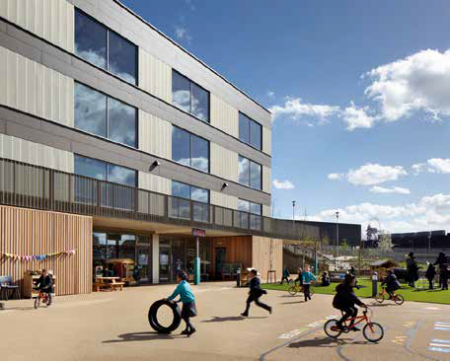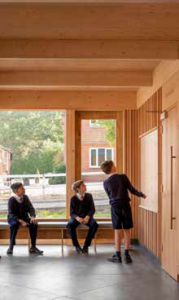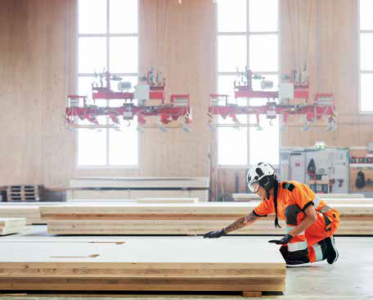Timber plays many roles in a learning environment with structural solutions only one of them. Mila Duncheva, Business Development Manager UK & Ireland, at Stora Enso Building Solutions outlines it contributions to lifelong learning.
A study by Cornell University found that subpar learning environments led to low test scores, absenteeism and poor academic achievement in schools. And that trend continues into the workplace, where the opposite is true. In fact, a more considered and cultivated working space, with plants and biophilic elements, improves self-reported wellbeing 15% and overall workforce productivity by 31%.
Setting the workforce up for commercial success should be seen as no different to setting future generations up for academic success. This is done by creating environments for their formative years in education, particularly when examination grades play such a crucial role in determining a student's future and so there's no reason why we shouldn't at least be thinking of building greener, healthier school environments for pupils. Against the backdrop of a £2.4billion cash crunch and teacher strikes over low-pay, local authorities and school management still mistakenly believe that traditional construction materials, such as concrete and steel might seem initially like the most obvious option for slashing construction costs. Instead, our recent cost study showed that by using cross laminated timber (CLT) elements, it is possible to cut the overall construction costs by more than a third. There are many reasons to believe that greener buildings not only can be possible within this financial context but must be in the wider one.

Build now and build well
In the face of tight school budgets why should school administrators be thinking about constructing new buildings at all? Over the past four years, England has seen an influx of additional students enter the primary and secondary school system, to fill the equivalent of over 12,000 classrooms. In response to this and the vast number of schools in need of refurbishment, the UK Government launched its school rebuilding programme in 2020. In some years, 50 schools are chosen, in others, 200. But even 200 schools are not enough, particularly when many projects are in need of refurbishments to make them safe, not necessarily increasing capacity or building anew.
As such, this still leaves a concerning gap between classroom availability and demand. Overall, growing class sizes and governmental focus on preventing collapse instead of creating new classrooms, means that creating quality spaces for young minds must be top of school administrators' own agendas when factoring in costs for the year.
Solving this with speed
Speed is an important factor for schools to consider and when it comes to speeding up construction, there's a few ways that this can be done – but we can't afford to let speed impede quality. One of these is doing as much as possible with modern methods of construction (MMC) – a favourable solution when schools only have a few months when children are away on holiday. Constructing the superstructure in a factory environment means finding a suitable material, like CLT elements that are precision[1]engineered in a factory, ready to slot together on-site when the time comes.
Many examples exist in the form of timber in the UK already, for example: Sherborne Girls School Arts Centre (B&K Structures, Dorset, 2018), and in higher education the New Model Institute for Technology and Engineering (Hybrid Structures, between Birmingham and Wales, 2021). Once assembled, these easy to build kits provide schools with the tools to minimise disruption and accelerate construction once on-site. This also allows for fewer deliveries to be made and less time spent on construction sites. In turn, this reduces labour costs and could very well eliminate the need to rent temporary classrooms (which tend to become permanent over the decades they remain on school grounds) whilst newer ones are being built. Lightweight enough to be transported to site in prefabricated parts, timber is an impressive candidate when it comes to constructing with innovative materials. When building with timber, there are some cost reductions per square metre, which make CLT a considerably attractive option for school buildings. If we're grading materials, timber also has impressive sustainability scores. In fact, each cubic metre of CLT is estimated to remove one tonne of climate damaging CO2 and store that in the building. With a prefabricated school kit, like Sylva™ by Stora Enso, it is possible to reduce emissions by up to 70% compared to a steel and concrete framed building.


Timber: better for mind and better for body
Timber also provides us with the opportunity to build more modern buildings, fully equipped for classes (and minds) of the 21st century. And unlike the schools of old, engineered wood is a safe building material without the risks of COSHH and RAAC. In an era where there is knowledge about these issues, choosing a safer material is a no brainer. And while some may fear the fire risk as a safety concern, evidence points to the fact that engineered timber, such as CLT, is designed to withstand fires up to 120 mins for safe evacuation and meets the same fire regulations as steel and concrete.
Moreover, studies on the effect of working in a timber environment have found that buildings with a biophilic design can lower stress levels, increase productivity and enhance creativity. These wellbeing benefits cannot be underestimated, especially as children catch up on education missed during COVID-19 lockdowns. Whilst schools might think that building high quality, modern buildings to foster imagination and boost wellbeing is not a priority, this investment is set to pay dividends in classroom creativity and academic outcomes later down the line.
Budgets will always be an issue that school administrations have to contend with – with or without governmental funding. With the ball now in their court, schools have the opportunity to undertake projects which will not only save time and money, but also make a tangible difference to wellbeing and the environment.
For more information visit: www.storaenso.com/en
Images:
01. Mila Duncheva, Business Development Manager UK & Ireland, at Stora Enso Building Solutions
02. Mossbourne Riverside Academy, London
03. David Brownlow Theatre, Newtown
04. CLT is produced in a precision factory environment









